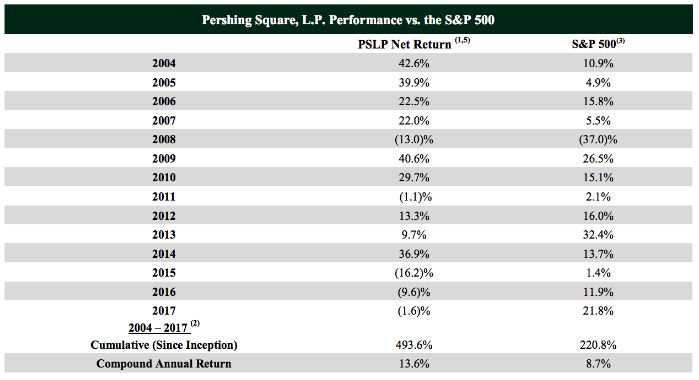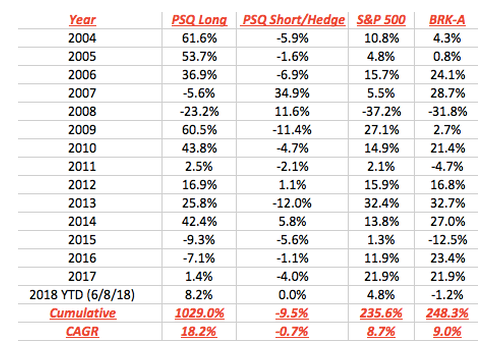
Bill Ackman is an American investor, hedge fund manager and philanthropist. He is the founder and CEO of Pershing Square Capital Management, a hedge fund management company. Ackman is considered by some to be a contrarian investor but considers himself an activist investor.
In 2004, with $54 million from his personal funds and his former business partner Leucadia National, Ackman started Pershing Square Capital Management. The fund produced an outstanding performance in its first 10 years, outperforming the S&P by a huge margin.
However, the fund's returns for 2015-2017 were not so great. However, even including those three years, the fund still significantly outperformed the S&P 500:

Those returns are after fees. The gross results (i.e. actual investment results without accounting for hedge fund fees) are even more impressive: showing Ackman beat both the S&P 500 and Berkshire Hathaway by over 770% with gross compounded annual returns of 18.2%.

Bill Ackman's hedge fund delivered 58% returns in 2019
Those "smart" investors who pulled money from the fund last year must feel not so smart right now. Their time horizons were just too short.
Recent study by DALBAR shows that invest ors consistently underperform the broad markets by significant margins. For the 30 years ending 12/31/2013, the S&P 500 Index averaged 11.11% a year. A pretty attractive historical return. The average equity fund investor earned a market return of only 3.69%
Fidelity Investments conducted a study on their Magellan fund from 1977-1990, during Peter Lynch’s tenure. His average annual return during this period was 29%. This is a remarkable return over the 13 year period. Given all that, you would expect that the investors in his fund made substantial returns over that period. However, what Fidelity Investments found in their study was shocking. The average investor in the fund actually lost money.
How is it possible?
Lynch himself pointed out a fly in the ointment. When he would have a setback, for example, the money would flow out of the fund through redemptions. Then when he got back on track it would flow back in, having missed the recovery.
This isn't about trading skills. The only skill those investors needed was to stick around. But what they did basically was "buy high sell low."
I'm sure the results for Pershing Square Capital Management would be similar.
The same behaviors apply to individual stocks. Amazon has gained 38,882% from its IPO in 1997, an annualized return of over 36%. To put that in perspective, a $100,000 investment in 1997 would be worth just under $39 million today. But it also experienced a 94% drawdown and few smaller drawdowns of 15-45%. I bet you will have a hard time finding many AMZN investors who had the guts to stick around and earn similar annualized returns.
Trading services are no different. As soon as a few losing trades and/or a drawdown of any kind occur, some traders hit the eject button and continue in their search for the Holy Grail strategy that always wins. They often come back after the next winning streak, having missed the recovery.
Isn't it the very definition of "Buy High, Sell Low"?
There will be bad days and bad weeks and bad months and periodically even a bad year. Focus on following your trading plan, not the short term results of it. Robust strategies are profitable in the long-term time frame.
Hedge funds, stocks, index funds and trading services are all investments. If your "buy" decision was based on years of solid performance, but your "sell" decision was based on few bad months, you have just become a part of the next Dalbar study.
What Is SteadyOptions?
Full Trading Plan
Complete Portfolio Approach
Diversified Options Strategies
Exclusive Community Forum
Steady And Consistent Gains
High Quality Education
Risk Management, Portfolio Size
Performance based on real fills
Non-directional Options Strategies
10-15 trade Ideas Per Month
Targets 5-7% Monthly Net Return
Recent Articles
Articles
Pricing Models and Volatility Problems
Most traders are aware of the volatility-related problem with the best-known option pricing model, Black-Scholes. The assumption under this model is that volatility remains constant over the entire remaining life of the option.
By Michael C. Thomsett, August 16

- Added byMichael C. Thomsett
- August 16
Option Arbitrage Risks
Options traders dealing in arbitrage might not appreciate the forms of risk they face. The typical arbitrage position is found in synthetic long or short stock. In these positions, the combined options act exactly like the underlying. This creates the arbitrage.
By Michael C. Thomsett, August 7

- Added byMichael C. Thomsett
- August 7
Why Haven't You Started Investing Yet?
You are probably aware that investment opportunities are great for building wealth. Whether you opt for stocks and shares, precious metals, forex trading, or something else besides, you could afford yourself financial freedom. But if you haven't dipped your toes into the world of investing yet, we have to ask ourselves why.
By Kim, August 7

- Added byKim
- August 7
Historical Drawdowns for Global Equity Portfolios
Globally diversified equity portfolios typically hold thousands of stocks across dozens of countries. This degree of diversification minimizes the risk of a single company, country, or sector. Because of this diversification, investors should be cautious about confusing temporary declines with permanent loss of capital like with single stocks.
By Jesse, August 6

- Added byJesse
- August 6
Types of Volatility
Are most options traders aware of five different types of volatility? Probably not. Most only deal with two types, historical and implied. All five types (historical, implied, future, forecast and seasonal), deserve some explanation and study.
By Michael C. Thomsett, August 1

- Added byMichael C. Thomsett
- August 1
The Performance Gap Between Large Growth and Small Value Stocks
Academic research suggests there are differences in expected returns among stocks over the long-term. Small companies with low fundamental valuations (Small Cap Value) have higher expected returns than big companies with high valuations (Large Cap Growth).
By Jesse, July 21

- Added byJesse
- July 21
How New Traders Can Use Trade Psychology To Succeed
People have been trying to figure out just what makes humans tick for hundreds of years. In some respects, we’ve come a long way, in others, we’ve barely scratched the surface. Like it or not, many industries take advantage of this knowledge to influence our behaviour and buying patterns.

- Added byKim
- July 21
A Reliable Reversal Signal
Options traders struggle constantly with the quest for reliable
By Michael C. Thomsett, July 20

- Added byMichael C. Thomsett
- July 20
Premium at Risk
Should options traders consider “premium at risk” when entering strategies? Most traders focus on calculated maximum profit or loss and breakeven price levels. But inefficiencies in option behavior, especially when close to expiration, make these basic calculations limited in value, and at times misleading.
By Michael C. Thomsett, July 13

- Added byMichael C. Thomsett
- July 13
Diversified Leveraged Anchor Performance
In our continued efforts to improve the Anchor strategy, in April of this year we began tracking a Diversified Leveraged Anchor strategy, under the theory that, over time, a diversified portfolio performs better than an undiversified portfolio in numerous metrics. Not only does overall performance tend to increase, but volatility and drawdowns tend to decrease: